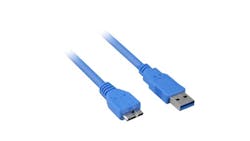Interview: TE Connectivity’s Egbert Stellinga Discusses USB 3.1
USB 3.0 is found on most new motherboards and mobile devices. It provides significantly higher throughput and more functionality than USB 2. Also, USB 3 provided backward compatibility with USB 2.0 in terms of connectors, though it hid additional connections. There were new USB 3 connectors as well, but they tended to be larger than the USB 2 connectors.
The USB 3.1 connector supports this higher-speed interface, and TE Connectivity (TE) is supplying these new connectors. Egbert Stellinga, product manager with TE Consumer Devices, has been with the company for almost 20 years. He also has managed many products and projects for several TE customers in mobile devices since 2001.
This file type includes high resolution graphics and schematics when applicable.
Wong: Why is there a new USB 3.1 connector?
Stellinga: Currently we see a few trends in mobile devices: increased data speed, increased charging power even beyond 5 A, and integration of video capabilities into the device. Other than USB 3.1 standard connectors, the HSMIO (high-speed multi-I/O) connector from TE can combine all of these features in one connector.
In addition, the USB 3.1 standard connector is designed similar to what we call the sidecar connector (see the figure). It is a double-size connector with two plugs next to each other. TE’s innovation drove a solution that captures all of the above into a micro USB 2.0-sized connector. The ultimate result provides USB 3.1 data speed and power charging plus video in a micro USB 2.0-sized connector.
Wong: What advantages does the HSMIO connector have over existing connectors?
Stellinga: Our product is one of the industry’s first high-speed multi-I/O connectors that transfers USB 3.1 signals in a micro USB 2.0 form factor. It handles data up to 10 Gbits/s supporting USB 3.1 Super-Speed and 3-A power delivery, but all in a smaller, micro USB 2.0-sized interface. Because of this ability to maintain high performance in this smaller size, our new product addresses the growing demand for mobile devices to have more increased functionality, higher speed, and larger screens that require high-power battery consumption.
Meanwhile, the connector’s small size, compatibility, durability, and improved electromagnetic interference (EMI) performance also present key advantages for use in small-size, battery-operated portable devices such as mobile phones, tablets, digital cameras, navigation devices, media players, and wearable devices.
Wong: What challenges or issues did TE encounter when designing the connectors, and how were they addressed?
Stellinga: In particular, the high-speed design and protection against EMI (electromagnetic interference) challenged our engineering team. Supporting the USB 3.1 standard requirement of 10 Gbits/s required extensive simulation and testing. Also, the EMI leakage of the USB signals required a particular construction of the shells in the cable assembly.
Wong: What advantages does TE’s solution provide?
Stellinga: As a world leader in connectivity, TE is committed to delivering extraordinary customer experiences. We strive to deliver miniaturization solutions that will help mobile device manufacturers create smaller, thinner, and lighter products. With an extensive global manufacturing footprint and product breadth, TE has a full range of the latest technologies to support consumer electronics applications. A prime example is this newly launched HSMIO connector. For more details on TE’s latest space-saving products, please visit www.te.com/en/product-launch/slim-solution.html.
About the Author
Egbert Stellinga
Product Manager, TE Consumer Devices
Egbert Stellinga has been with TE Connectivity (TE) for almost 20 years. He started his career in engineering and project management, and this experience has provided a broad base for the product management position he currently holds. Located in the Netherlands, he has managed many products and projects for several TE customers in the mobile devices area since 2001.
William G. Wong
Senior Content Director - Electronic Design and Microwaves & RF
I am Editor of Electronic Design focusing on embedded, software, and systems. As Senior Content Director, I also manage Microwaves & RF and I work with a great team of editors to provide engineers, programmers, developers and technical managers with interesting and useful articles and videos on a regular basis. Check out our free newsletters to see the latest content.
You can send press releases for new products for possible coverage on the website. I am also interested in receiving contributed articles for publishing on our website. Use our template and send to me along with a signed release form.
Check out my blog, AltEmbedded on Electronic Design, as well as his latest articles on this site that are listed below.
You can visit my social media via these links:
- AltEmbedded on Electronic Design
- Bill Wong on Facebook
- @AltEmbedded on Twitter
- Bill Wong on LinkedIn
I earned a Bachelor of Electrical Engineering at the Georgia Institute of Technology and a Masters in Computer Science from Rutgers University. I still do a bit of programming using everything from C and C++ to Rust and Ada/SPARK. I do a bit of PHP programming for Drupal websites. I have posted a few Drupal modules.
I still get a hand on software and electronic hardware. Some of this can be found on our Kit Close-Up video series. You can also see me on many of our TechXchange Talk videos. I am interested in a range of projects from robotics to artificial intelligence.



